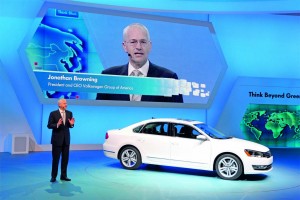
VW Group CEO Jonathan Browning -- shown here at the 2012 Detroit Auto Show -- wants more product in the U.S. line-up.
With U.S. sales expected to increase by as much as 30% for May Volkswagen is looking at all its options to keep that momentum going – including the addition of all-new products to its American line-up.
The maker could start importing several models not currently sold in the U.S., said Volkswagen Group of American CEO Jonathan Browning. But the executive says the more likely move would come with the addition of an all-new midsize SUV now “under discussion.”
“A midsize SUV would be a great opportunity for us,” Browning said following a speech to the Detroit Automotive Press Association.
The vehicle would slot into the line-up between the compact Tiguan and the full-size Touareg sport-utility vehicles. It might be developed as a joint project between the U.S. and “another region around the world,” Browning hinted, but he stressed that the American market would take the lead in the vehicle’s development.
No set date has been set for its launch but based on where the project appears to be in the product pipeline several well-placed observers suggested it could reach market by mid-decade.
That would be a perfect fit for VW, which is gunning to triple its sales to 800,000 annually by 2018 – a figure that includes not only the Volkswagen brand but also the more luxurious Audi and ultra-exclusive Bentley marques.
After years of lagging behind their competitors, VW and Audi, in particular, have been gaining significant momentum, the flagship Volkswagen brand itself growing by 38% during the first four months of this year alone.
Much of that growth has been fueled by VW’s decision to deliver products more attuned to the American marketplace. That notably includes the 2012 Passat which is significantly different from the model sold in Europe and other parts of the world.
It also has helped to have a new factory in Chattanooga, Tennessee to produce the sedan. VW plans to produce the 100,000th Passat to roll out of the new plant tomorrow. Demand has been strong enough to encourage the maker to add a third shift. Once it is up to full speed, by the third quarter, capacity should jump to around 180,000 vehicles annually, according to Browning. And by “breaking bottlenecks” that could climb to 250,000 – though VW could further expand the facility, the executive confirmed.
The goal for VW is to ultimately produce at least 70% of the vehicles it sells in the U.S. somewhere in the NAFTA region. The maker also operates a facility in Puebla, Mexico currently capable of assembling 600,000 vehicles annually, though that factory also supplies a variety of other markets.
While a new midsize sedan is at the top of the list for Browning, he suggested VW is looking at filling /some other niches in the market using products not currently available State-side. That could very well include the Polo, a hatchback one size smaller than the Volkswagen Golf, as well as VW’s new microcar, the Up!
But Browning stressed that if either model were to wind up in U.S. showrooms, “We would need to source those in the North American region,” likely building them either in Puebla or Chattanooga. Even with the dollar gaining ground against the Euro in recent weeks it would be difficult to make a business case importing either model from Europe.
For the near-term, the Chattanooga plant will continue producing just the Passat. But as capacity grows and as the sedan ages it is likely that an additional model would be added there, the executive suggested.
Ironically, the weakening European economy has actually been a boon to Volkswagen’s U.S. operations, making it easier to get models in short supply as well as components needed at the Chattanooga plant, Browning noted, including diesel engines.
The maker was anticipating that diesels would account for 15% to 20% of overall Passat sales but that is already at 20% — and Browning said VW is hoping to expand capacity to bring that to 30% by the time the third shift in Chattanooga is running at full speed.
